When I descended down the stairway of the Temple of the Cross within the ancient Maya archaeological site Palenque, I simply continued with my leisurely visit. Thus I passed once again beside the Temple of the Sun.
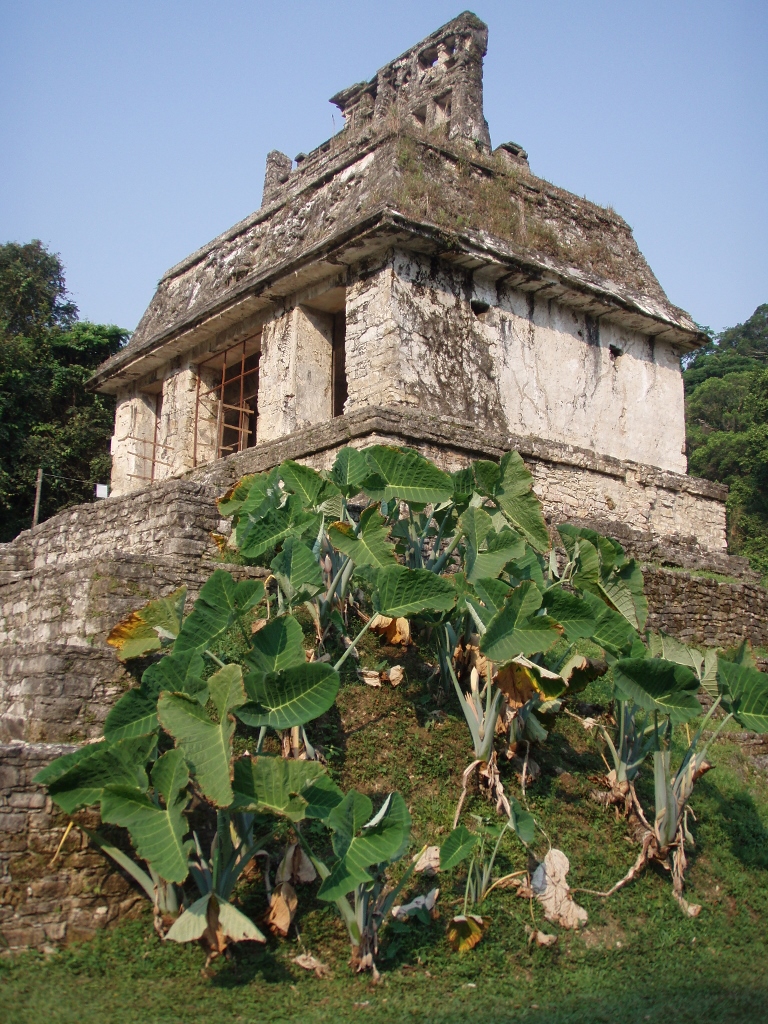 Temple of the Sun
Temple of the Sun
I also had (again) a splendid view at the central part of the site with the Temple of the Inscriptions and the Palace.
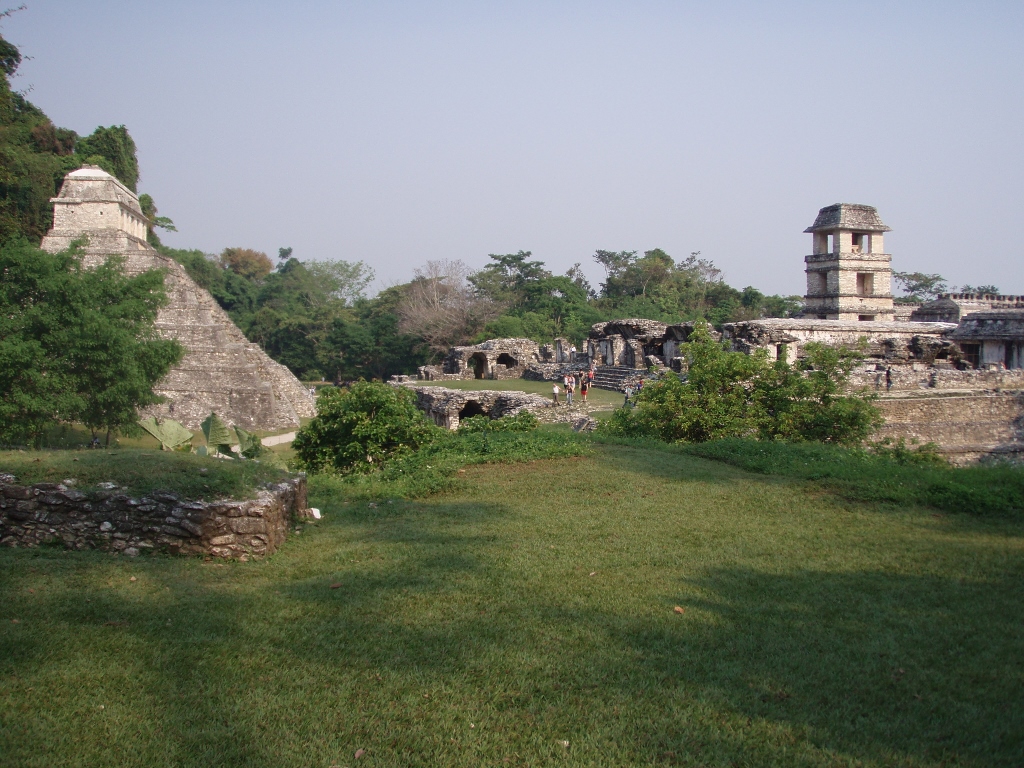 Temple of the Inscriptions and the Palace
Temple of the Inscriptions and the Palace
Further strolling around Palenque took me beside the Palace, now from the east side, but I still did not make a stop there, leaving rather my visit for the very end. This did not prevent me from enjoying its beauty as seen from the outside.
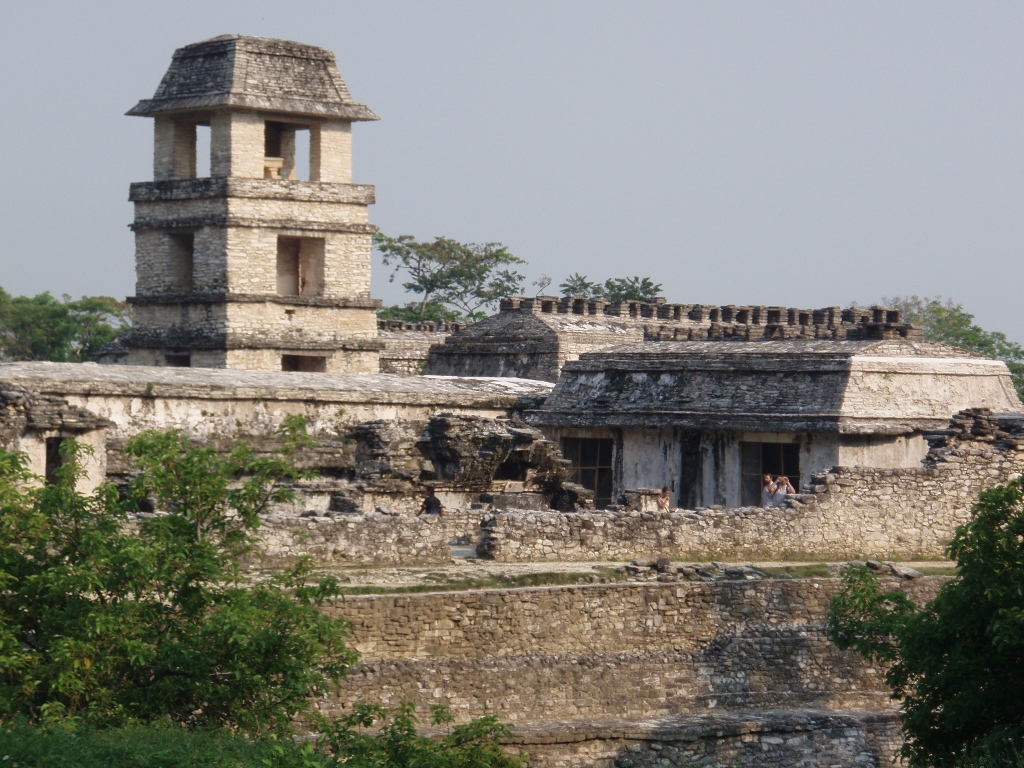 Palace – southeast corner
Palace – southeast corner
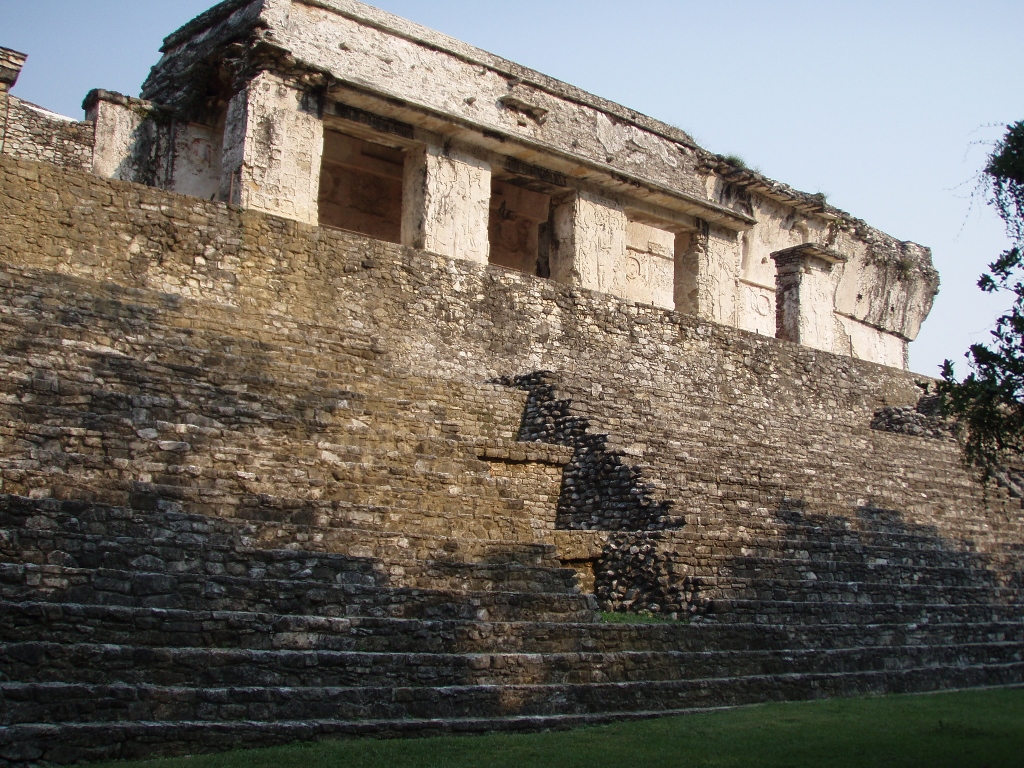 Palace – stairway on the east side
Palace – stairway on the east side
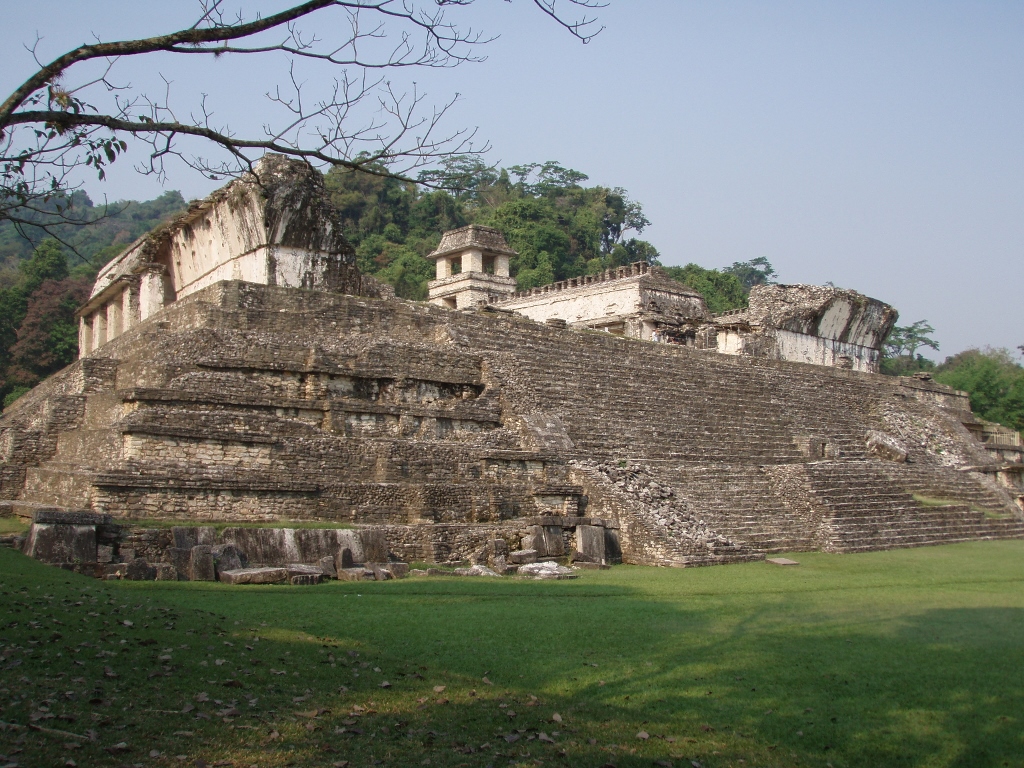 Palace – stairway on the north side
Palace – stairway on the north side
In fact, I was heading for the North Group and there was also the Ballcourt.
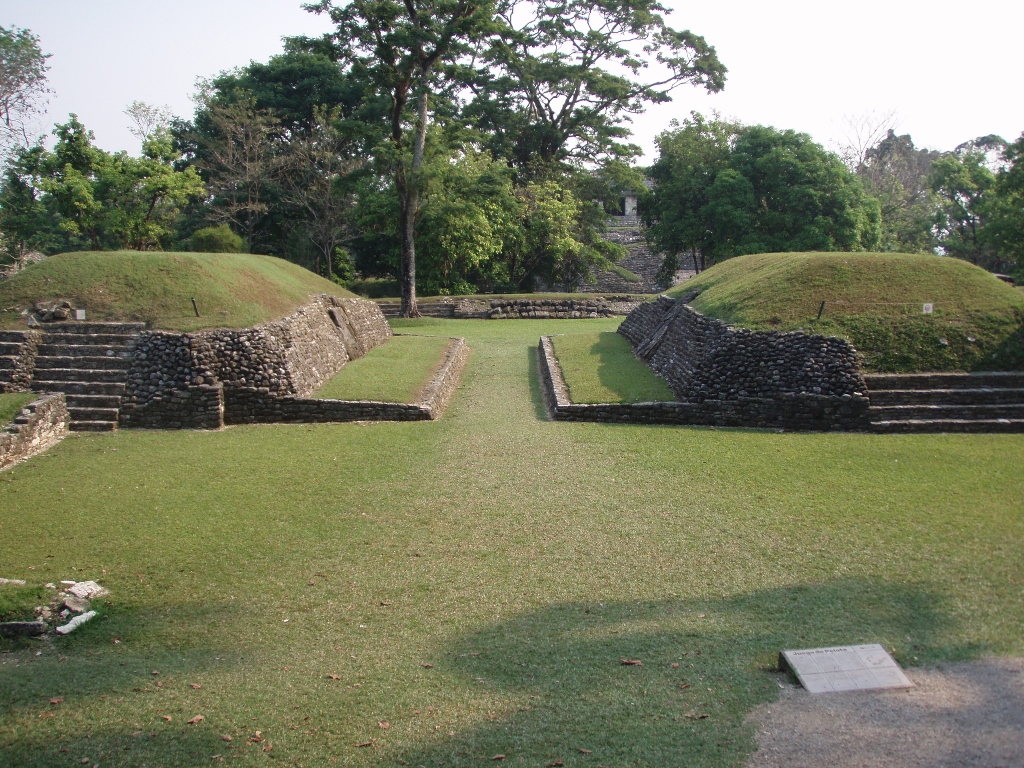 Ballcourt
Ballcourt
As it may be seen, this ballcourt is not very big, although this is only the remains of the original structures (here I’m primarily thinking of the grassy “caps” on the platforms and the lack of the stone rings through which the ball was supposed to be thrown). It is certainly very well arranged and maintained, just like the rest of the site after all.
I walked right through the court and continued towards the nearby North Group, but to start with I had to go over a long and wide platform. Before descending to the level of the North Group, Palenque all being in different tiers because it follows the mild sloping of the terrain, once again I looked back in order to see the end of the Ballcourt, as well as parts of the Palace.
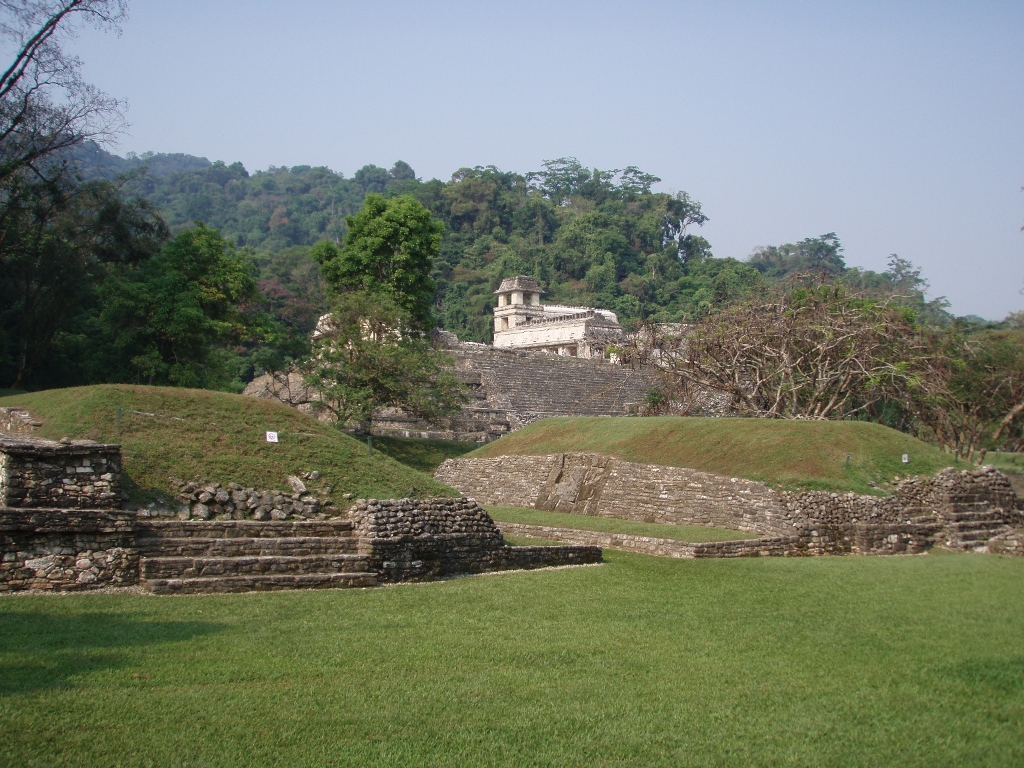 View at the Ballcourt and the Palace
View at the Ballcourt and the Palace
When I turned in order to continue, I realised that right there in front of me there was a large mango tree. However, what I found particularly interesting about this tree, which grows freely here giving fruits that are both in my country and throughout Europe considered exotic and comparatively expensive, was that a lot of its fruits had fallen to the ground from the tree – just like plums in my country.
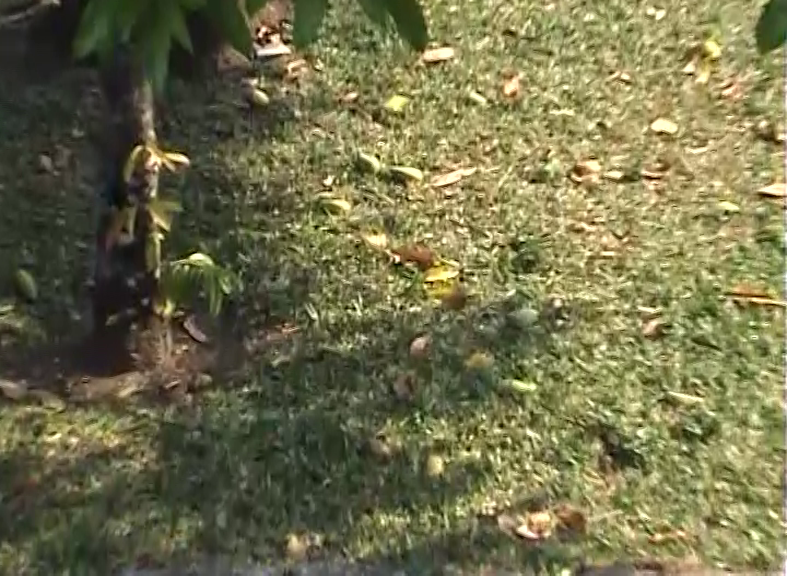 The photo is not ideal (made from a video recording), but it is still possible to discern green mango fruits that have fallen to the ground
The photo is not ideal (made from a video recording), but it is still possible to discern green mango fruits that have fallen to the ground
But, let me go back to the visit of the North Group. These are several temples of different sizes built on the same stepped platform.
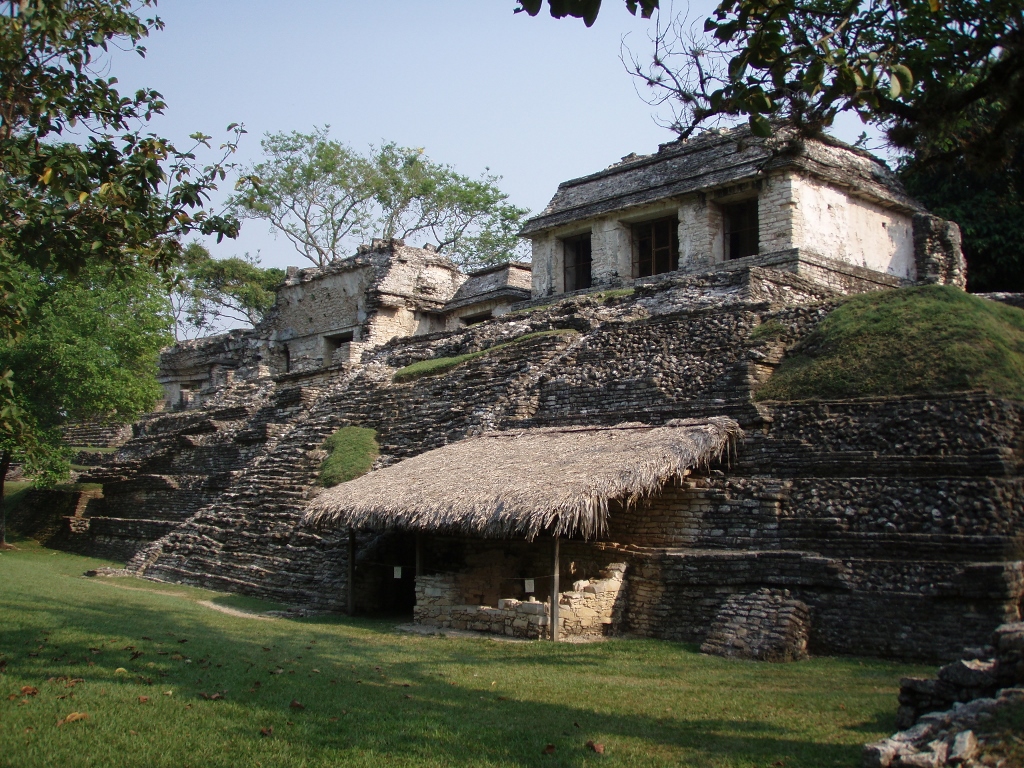 North Group
North Group
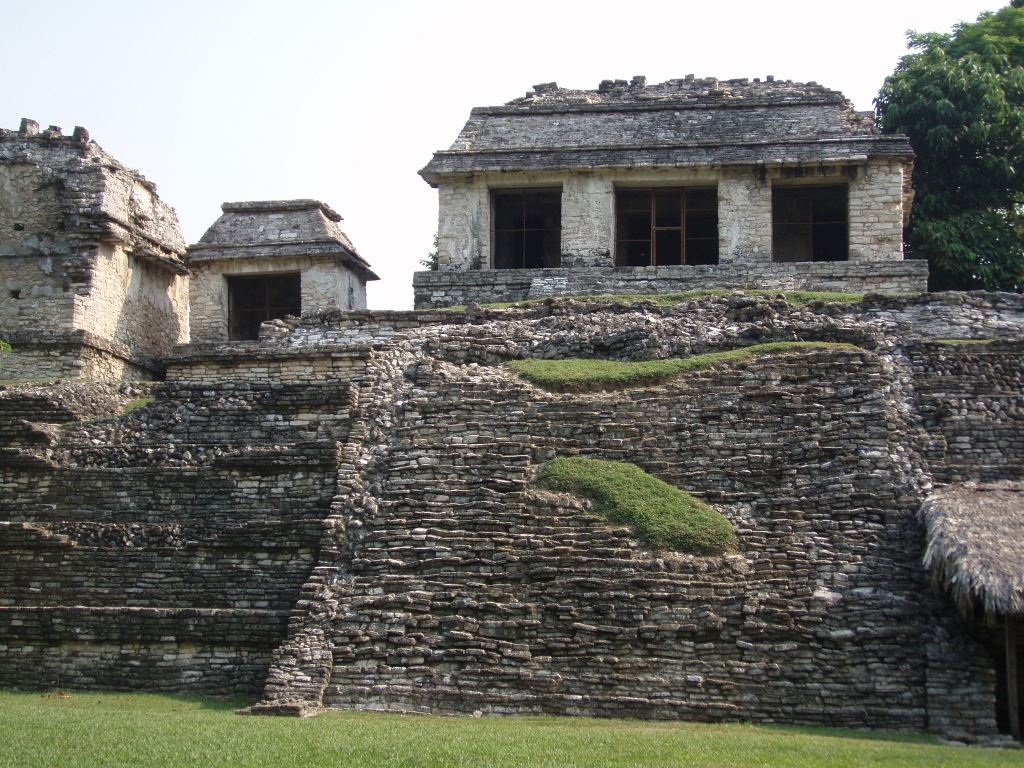 North Group
North Group
One of the interesting details in the case of this group is a stone relief that shows god Tlaloc. Although god Tlaloc was primarily an Aztec god, while the Mayas had their own version in the shape of god Chaac traditionally shown in a specific way, which I have already written about before, it is still possible to find among the Mayas the depictions of Tlaloc rather than that of Chaac. Both gods are primarily linked to the sphere of rains, lightning, thunder, water and soil fertility, but among the Mayas Tlaloc is additionally linked with the warfare and the offering of sacrifice, since both of these activities entailed large quantities of blood and it is presumed that the Maya people made this association since the Aztecs regularly offered as sacrifice to their god Tlaloc the Mayas they had captured.
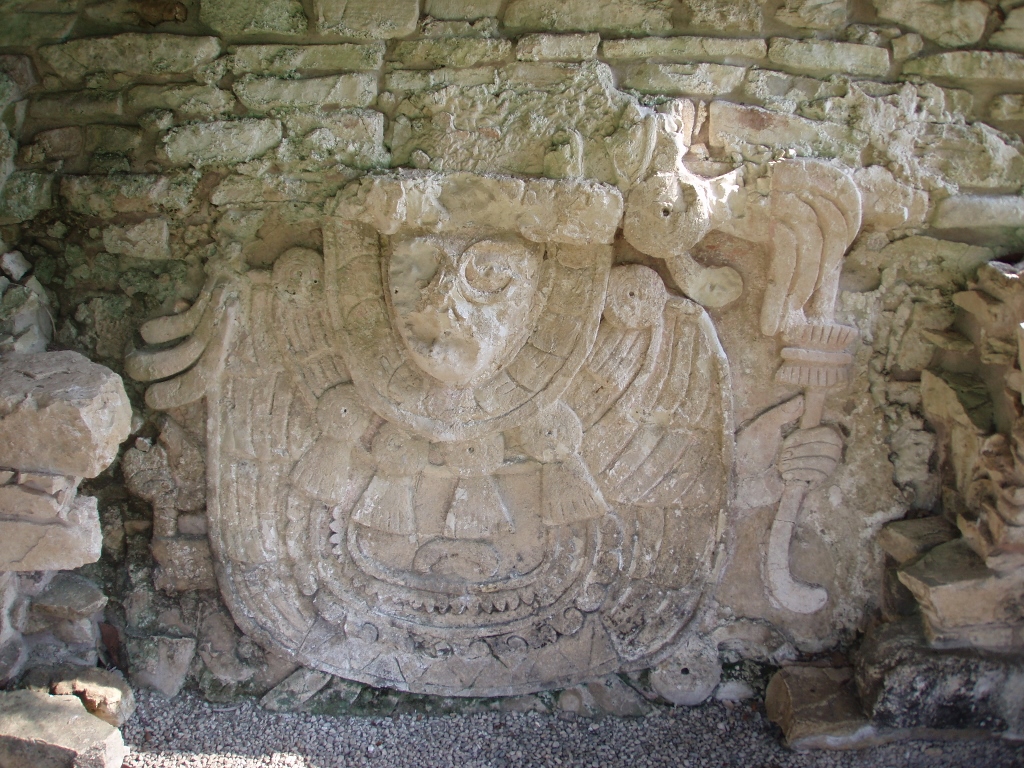 North Group – god Tlaloc
North Group – god Tlaloc
Right next to the North Group there is also the Temple of the Count (Templo del Conde). The temple was named like this because during the 1830’s a self-proclaimed count from Europe lived in this structure for a couple of years. This eccentric story aside, within this temple there is a tomb of an unknown member of royalty.
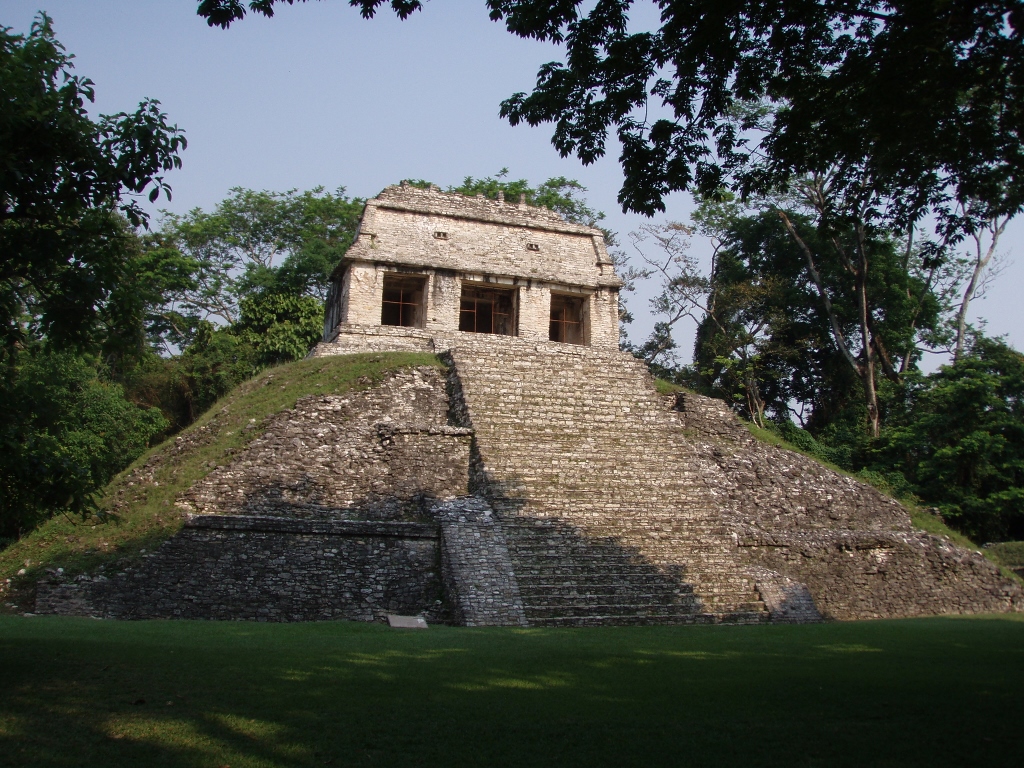 Temple of the Count
Temple of the Count
And then I finally headed for the Palace with intention to visit it thoroughly at this point.
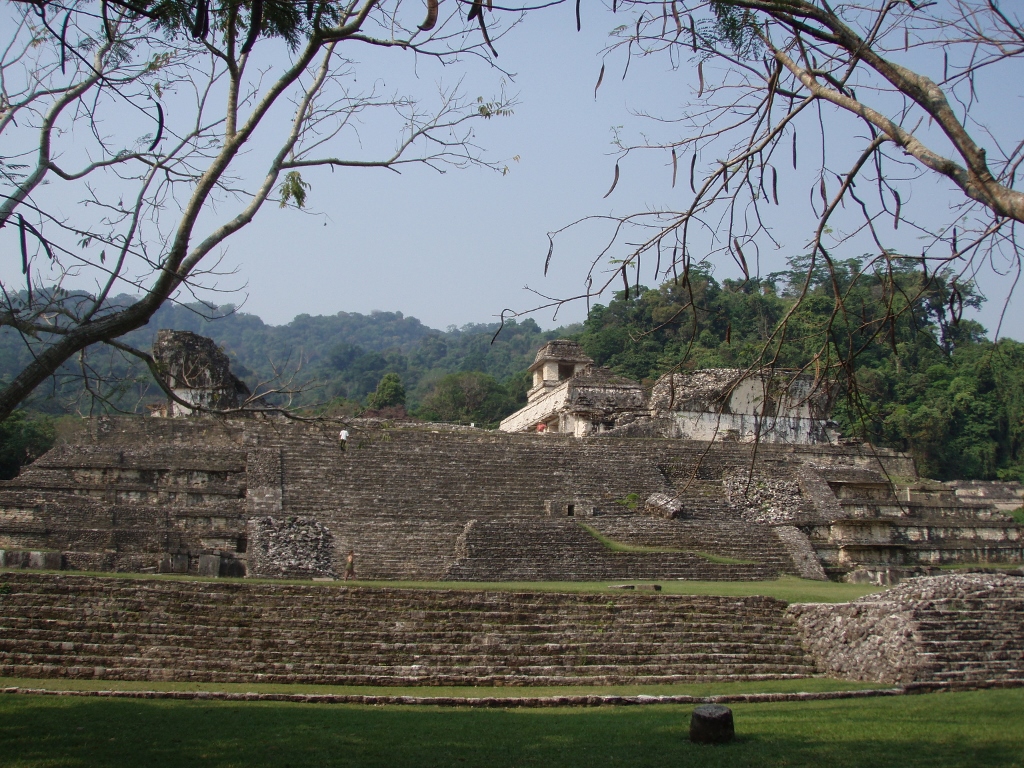 Palace – north stairway
Palace – north stairway
I decided to enter the Palace from the west side and there was also a very fine view of the Temple of the Inscriptions from here.
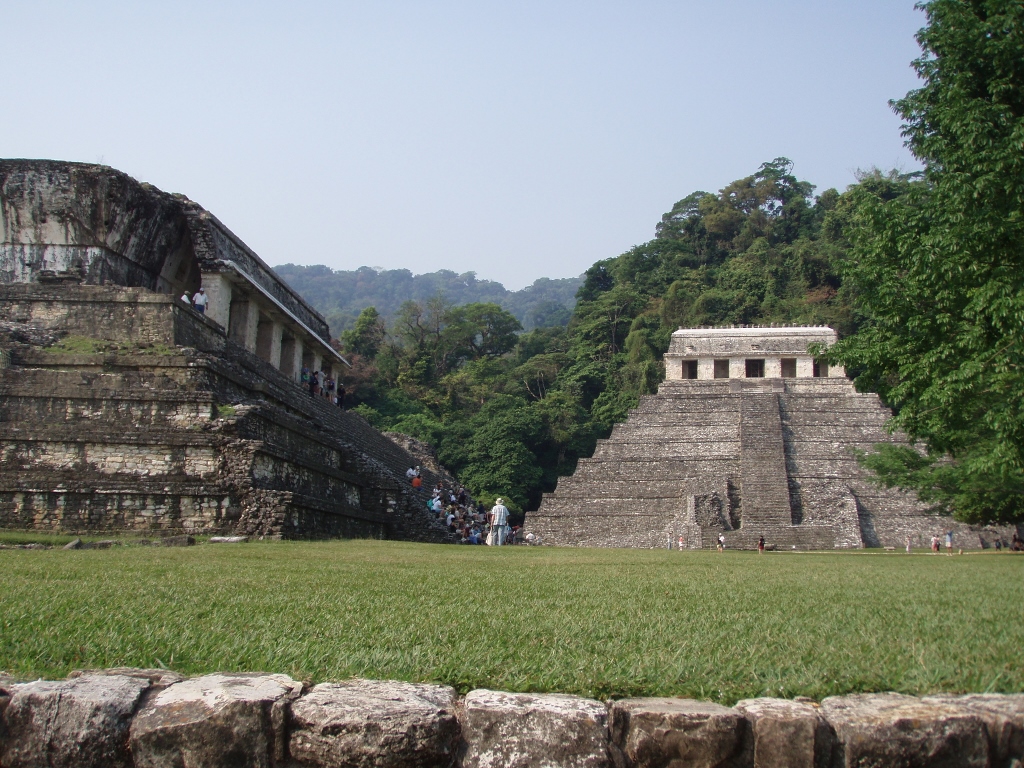 Palace and the Temple of the Inscriptions
Palace and the Temple of the Inscriptions
Together with the Temple of the Inscriptions, the Palace is the most important structure in Palenque. This is a complex that includes several structures with rooms, as well as numerous courtyards and corridors. The construction of the Palace spanned across around four centuries, since different generations of the local Mayan rulers built their additions. The Palace is situated on a built platform that is 97 m long, 73 m wide and 10 m high.
As I climbed the stairway on the west side, I came across a very pretty stuccowork decoration made on a pillar.
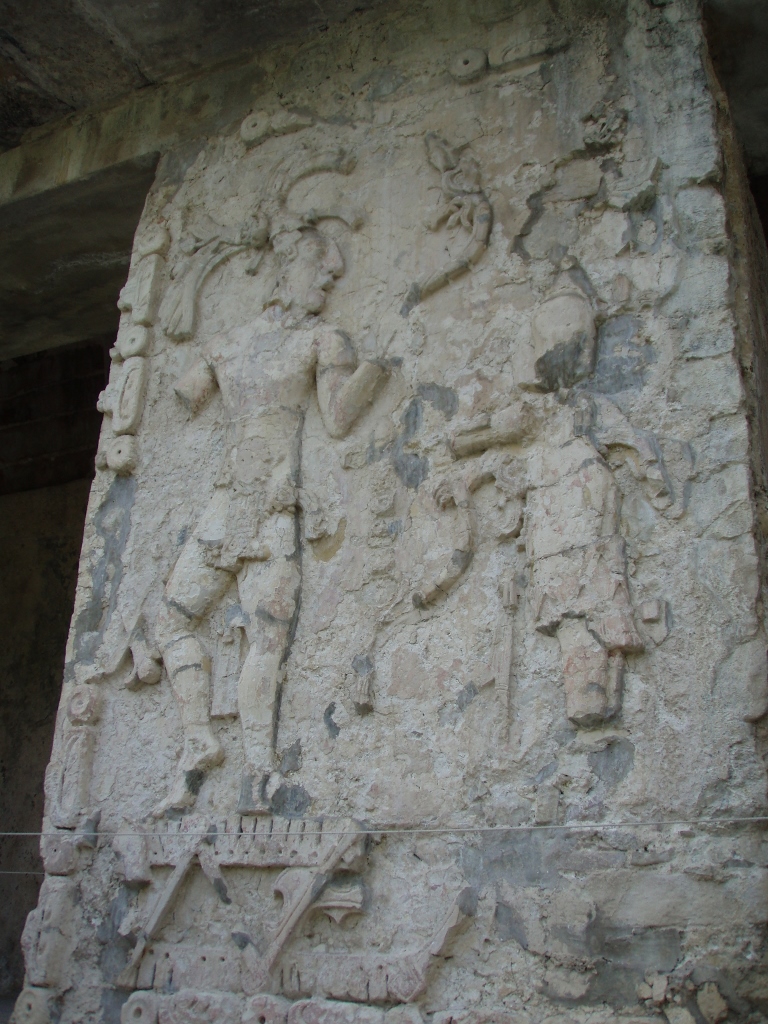 Palace – relief decoration on a pillar
Palace – relief decoration on a pillar
Then I entered into the space of the Palace which actually served as the centre for different secular and sacral ceremonies, although it is also believed that the royal family also lived here together with their entourage. I’ve already said that this complex, which is located in the middle of Palenque, has several courtyards, two of which are somewhat bigger.
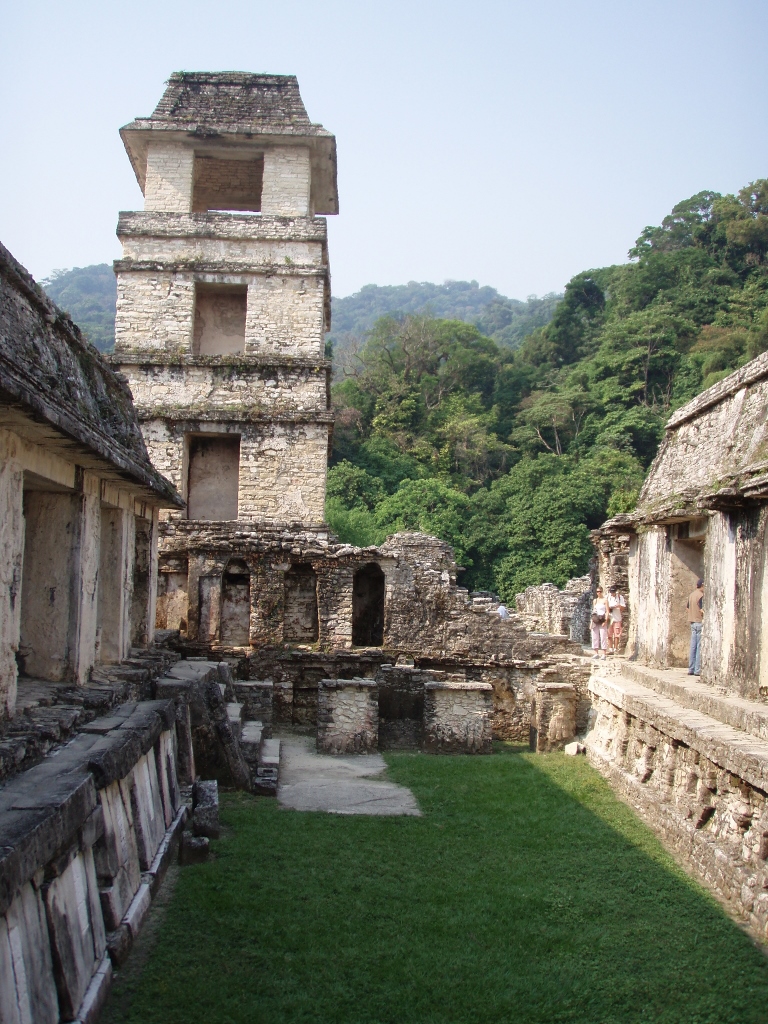 Palace – one of the two larger courtyards
Palace – one of the two larger courtyards
From this point there was a very fine view at the tower that constitutes one of the most noticeable elements within entire Palenque. It is presumed that it served as an observatory and the place for the general surveillance of the surroundings, and therefore it is called the Observation Tower.
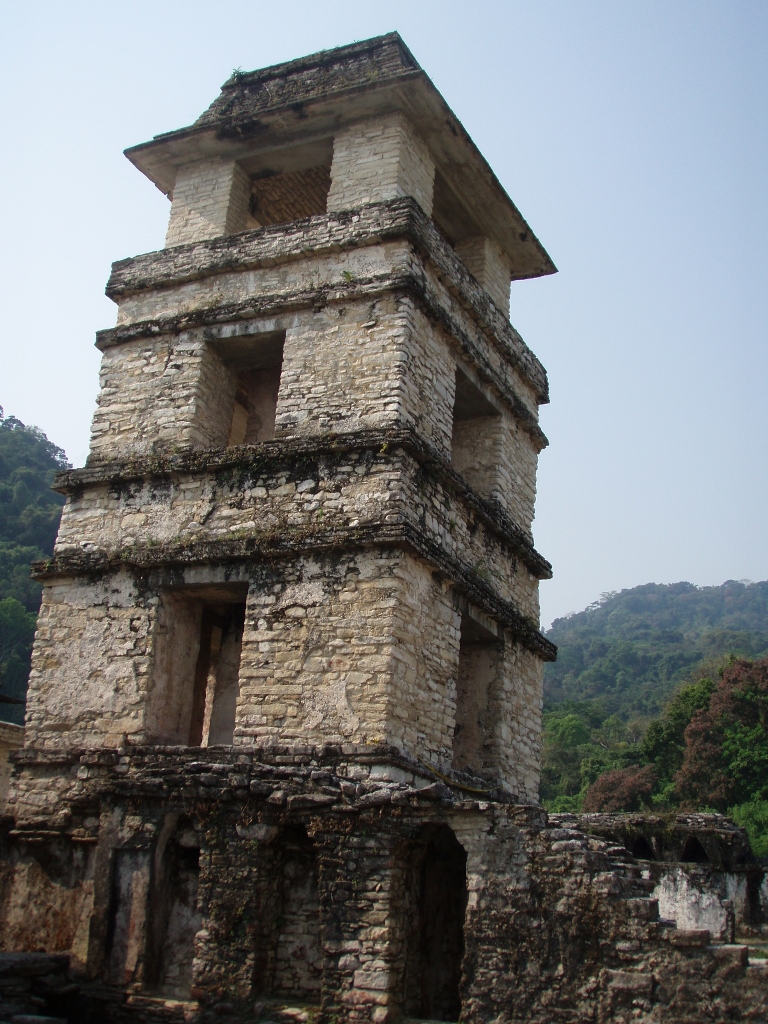 Observation Tower in Palenque
Observation Tower in Palenque
Then I got to the biggest courtyard called the Sunken Courtyard where beside a stairway there are several bas-reliefs depicting prisoners. Nowadays, these bas-reliefs are protected by a canopy in order to prevent further deterioration by rain-caused erosion.
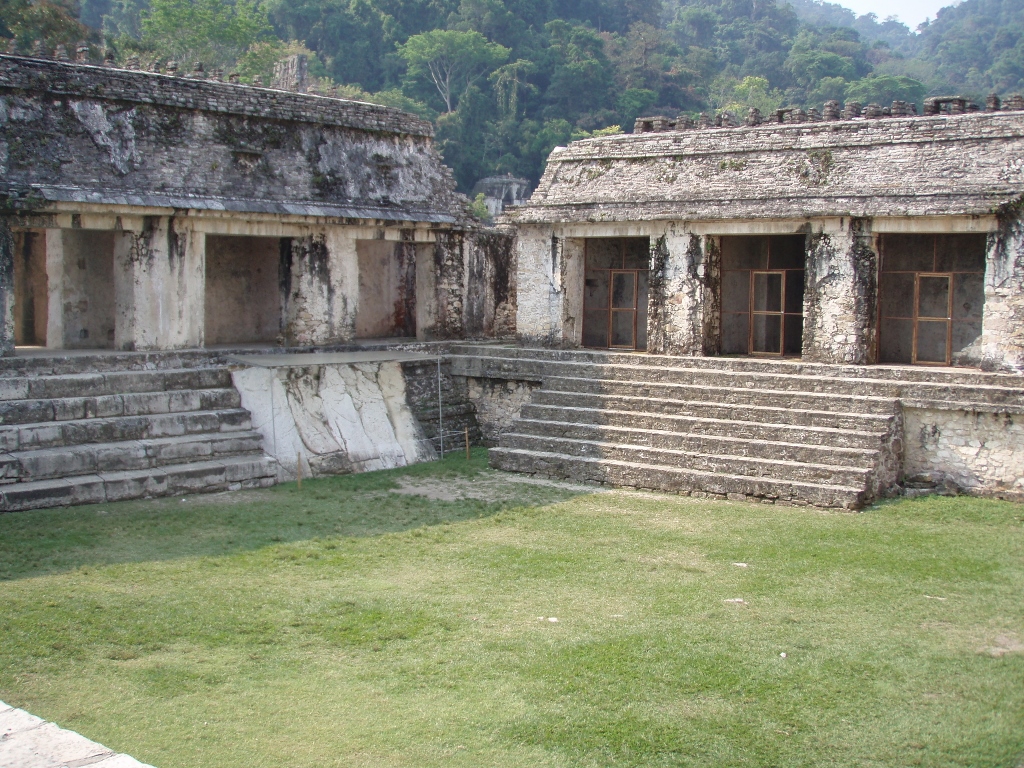 Sunken Courtyard
Sunken Courtyard
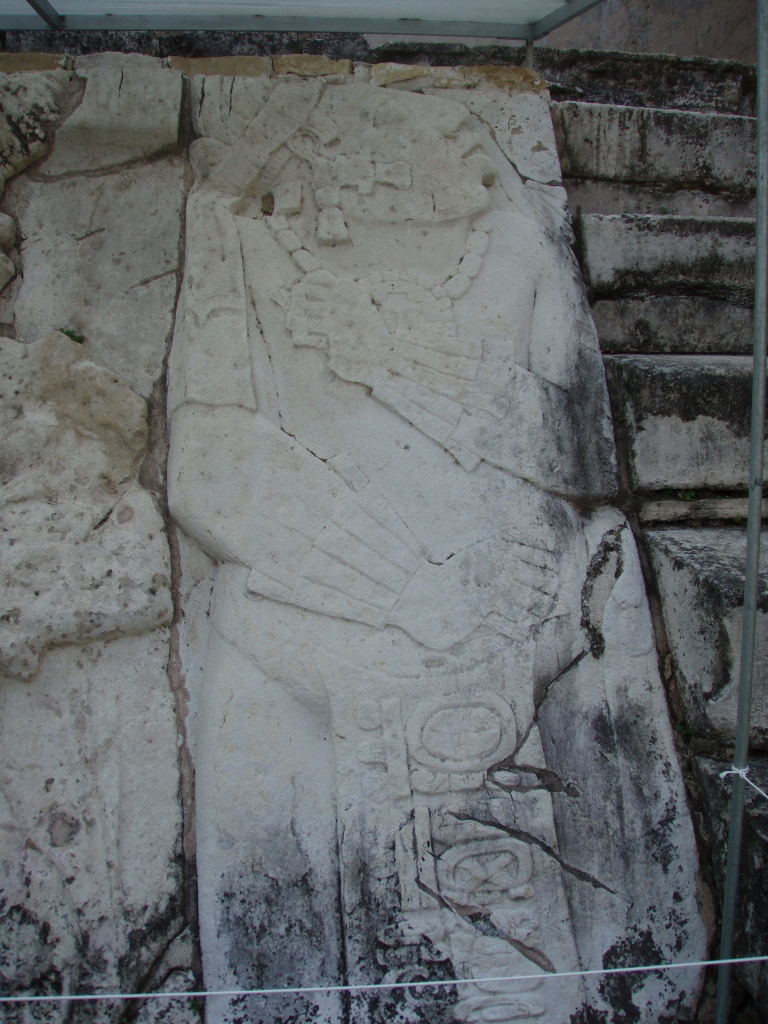 Sunken Courtyard – bas-reliefs
Sunken Courtyard – bas-reliefs
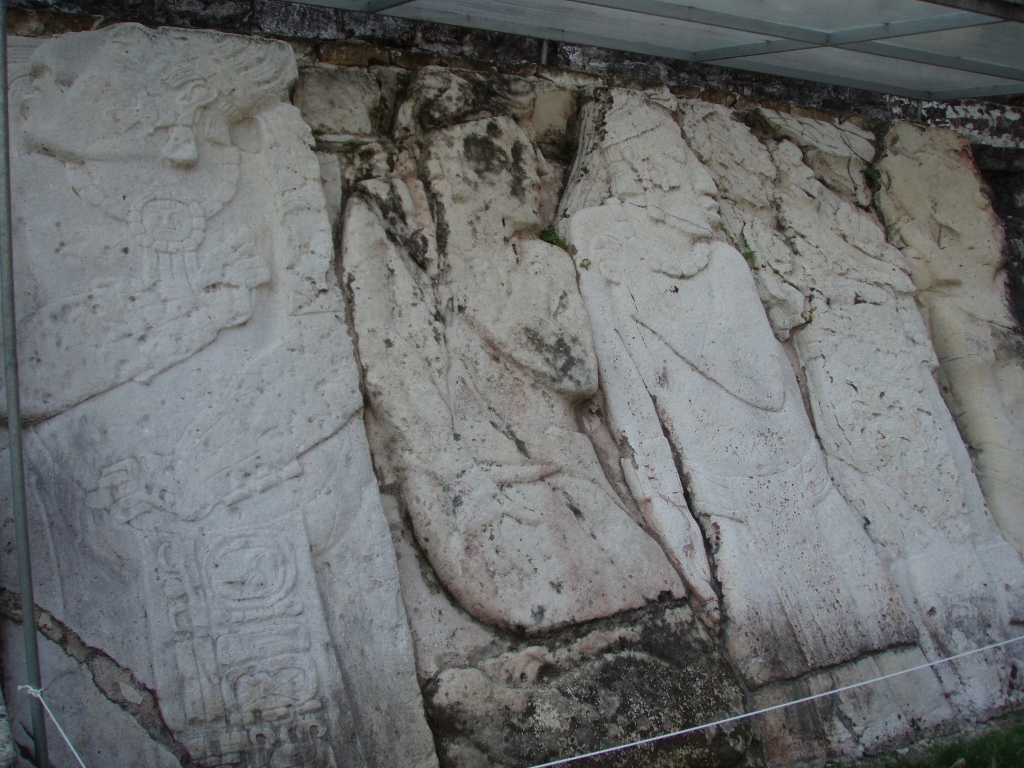 Sunken Courtyard – bas-reliefs
Sunken Courtyard – bas-reliefs
Among these human figures I also noticed one that I thought looked very interesting. Perfect for all those who like the theories about alien visitations.
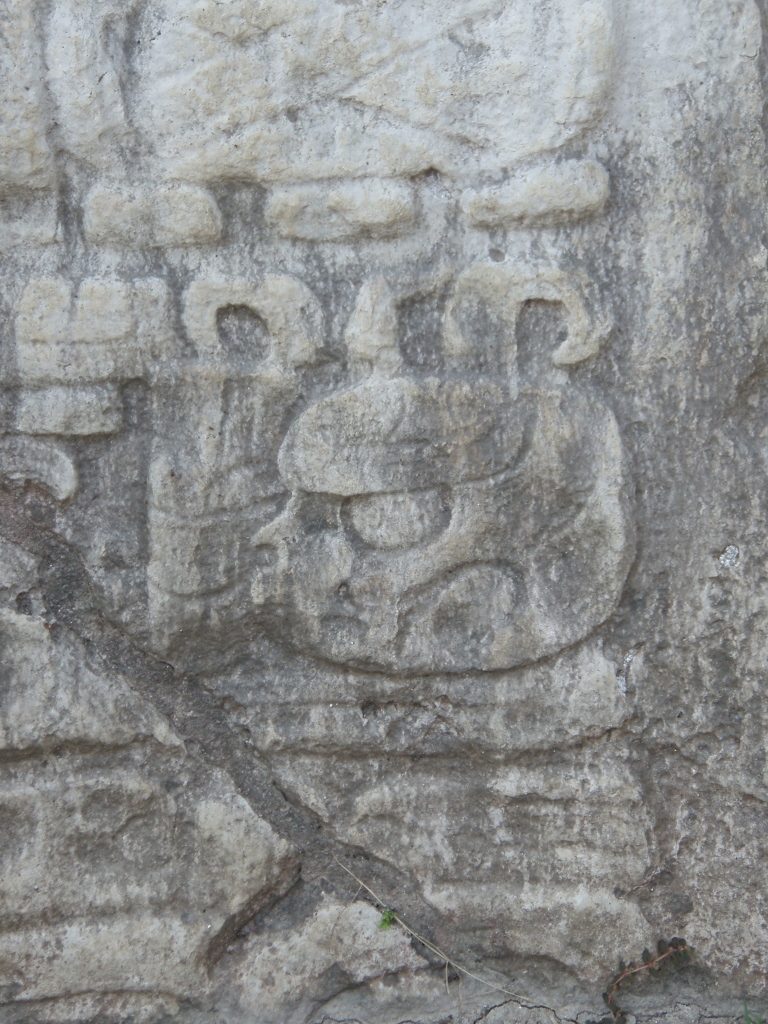 Sunken Courtyard – what is this, a bear cub with rabbit ears and sunglasses?
Sunken Courtyard – what is this, a bear cub with rabbit ears and sunglasses?
I circled around the Sunken Courtyard and then continued with my visit of the Palace.
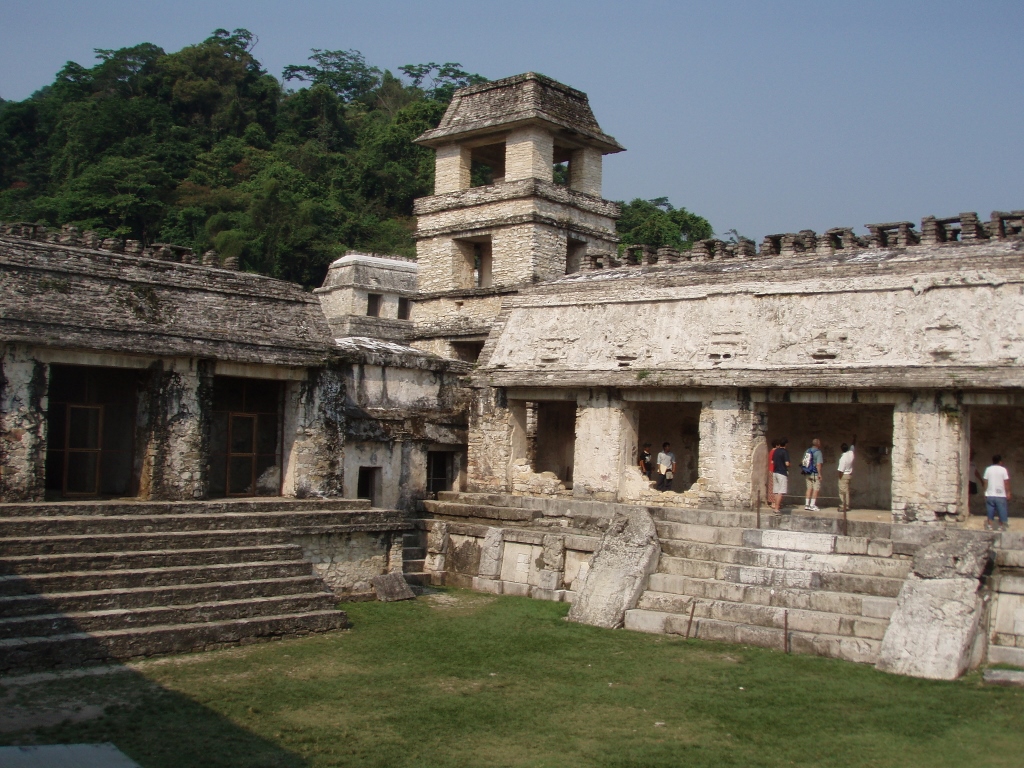 Sunken Courtyard
Sunken Courtyard
Within the Palace there are also numerous narrow corridors and they were all built by applying corbel arch, which is something I have already written about before.
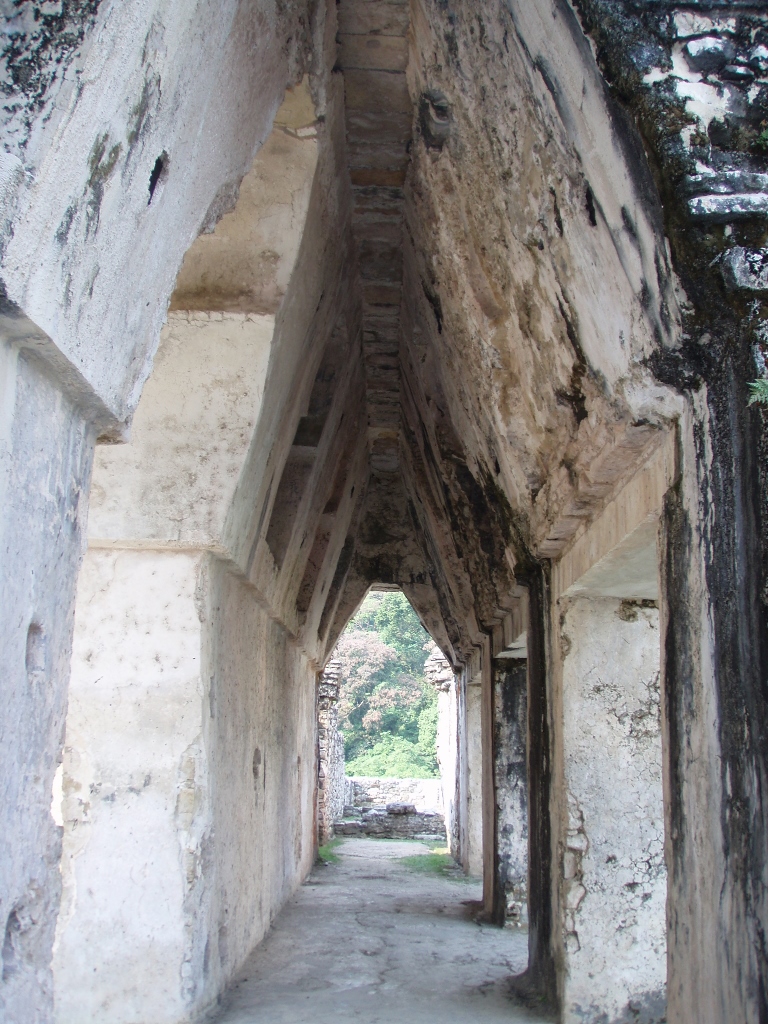 Corridor with corbel vault at the Palace in Palenque
Corridor with corbel vault at the Palace in Palenque
On the walls of some of the structures it is still possible to see remains of relief decorations and there are also regular openings in the walls in the shape of the letter T.
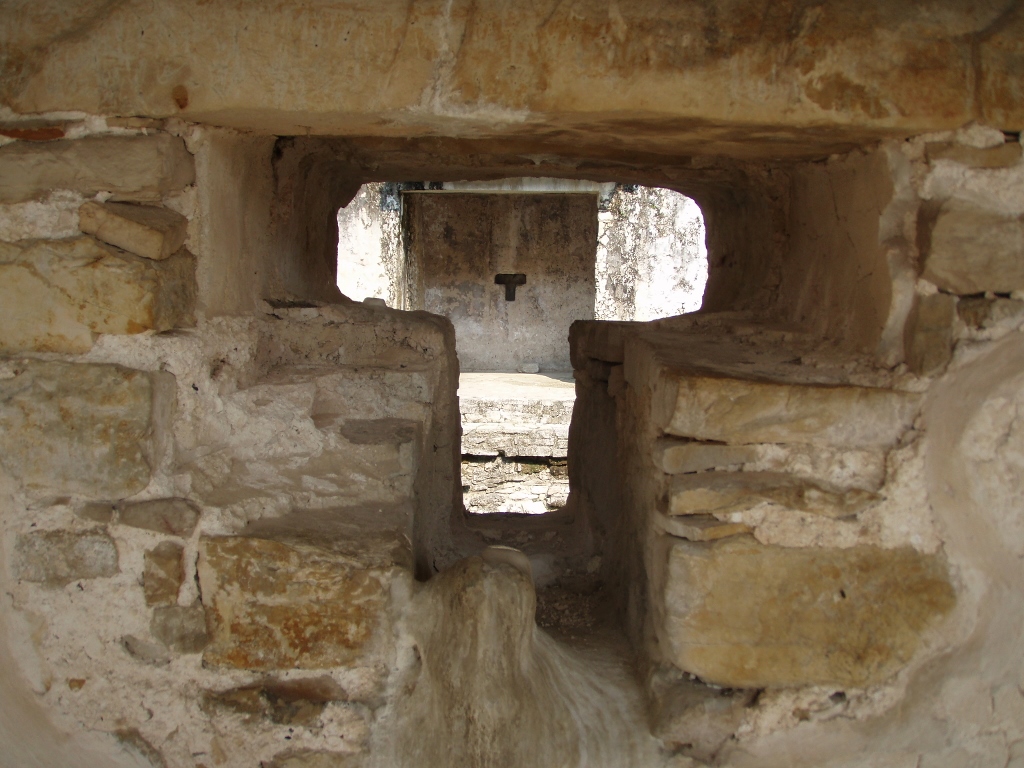 Detail from the Palace
Detail from the Palace
I continued with my walk around the Palace and along the way I took photos of some details I found interesting.
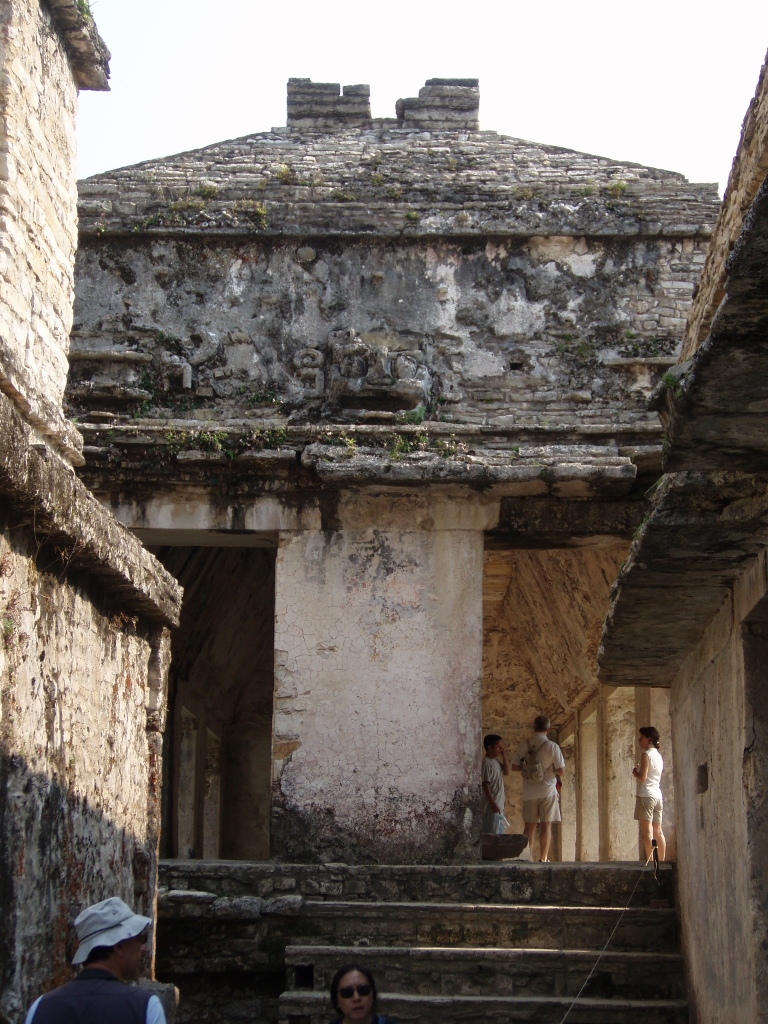 Lateral side of one of the structures
Lateral side of one of the structures
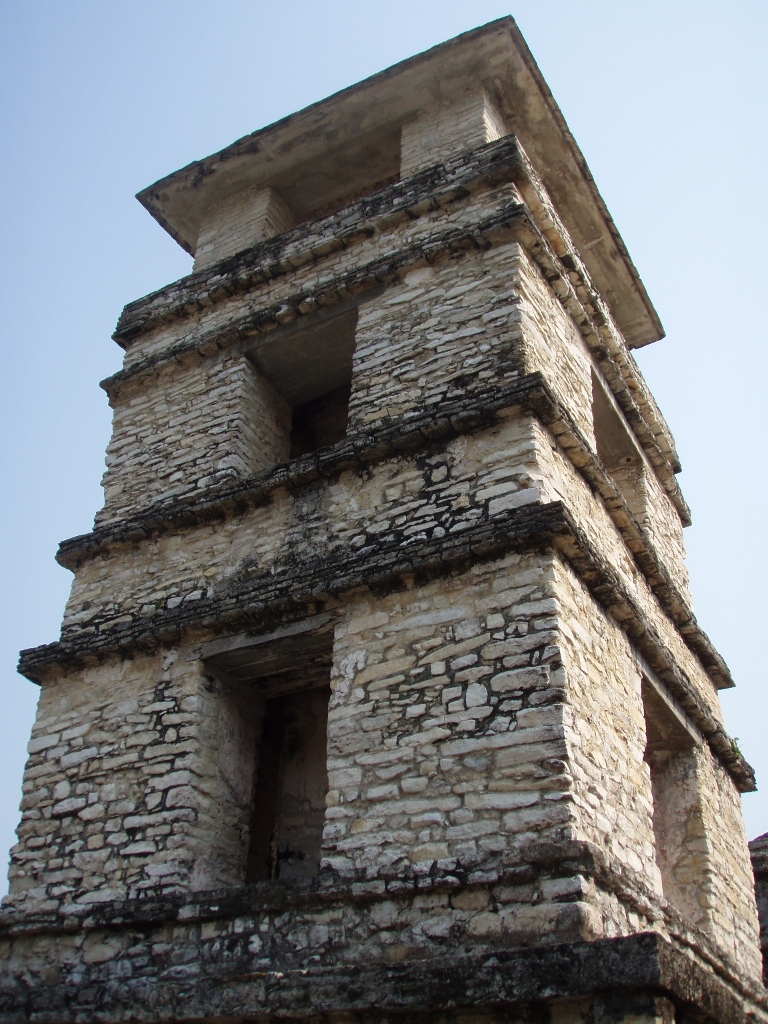 Again a view at the Observation Tower
Again a view at the Observation Tower
And then, while I was getting ready to take a photo of myself at one place, there came a group with their guide, so he was telling them about a detail that could be seen from there and I overheard this by simply being in the same spot as they.
Namely, the Palace used to have a large number of bathrooms and saunas that were supplied with fresh water thanks to a complex practically waterworks system that the Mayas made at Palenque. But, we are humans and apart from liking having bathrooms, we also have certain physiological needs that require a solution. Since there are canals under the Palace through which water is still flowing, it sufficed to make a hole, but the Maya also came up with a mini-platform – a proper ancient squat toilet!
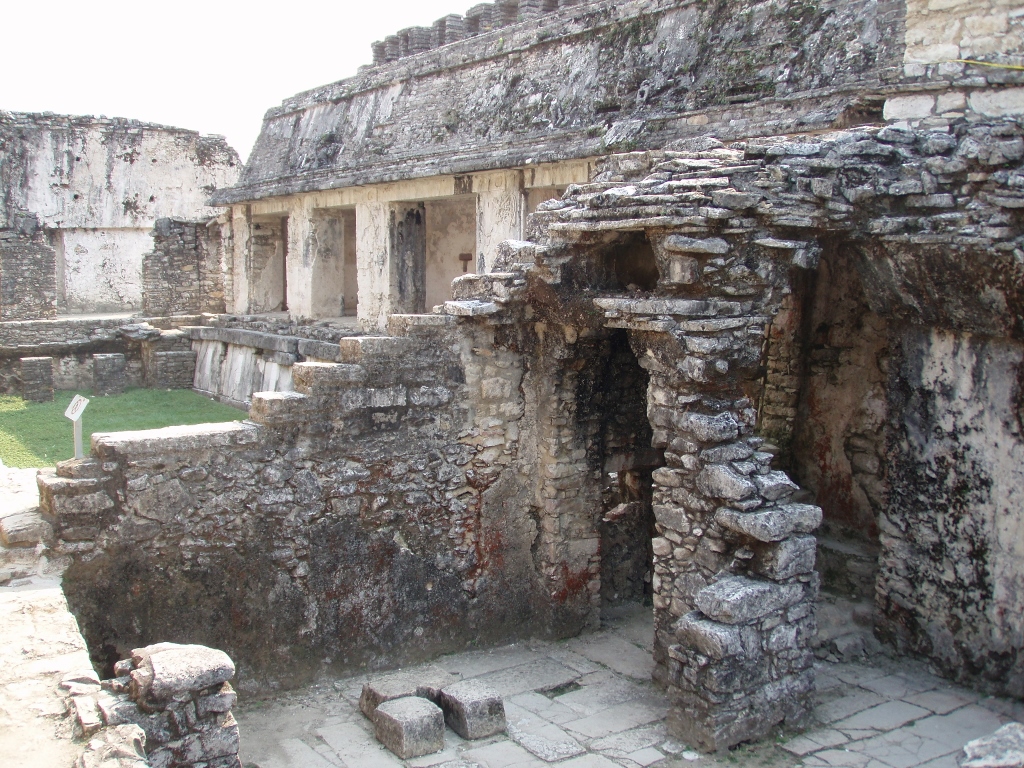 Toilet within the Palace
Toilet within the Palace
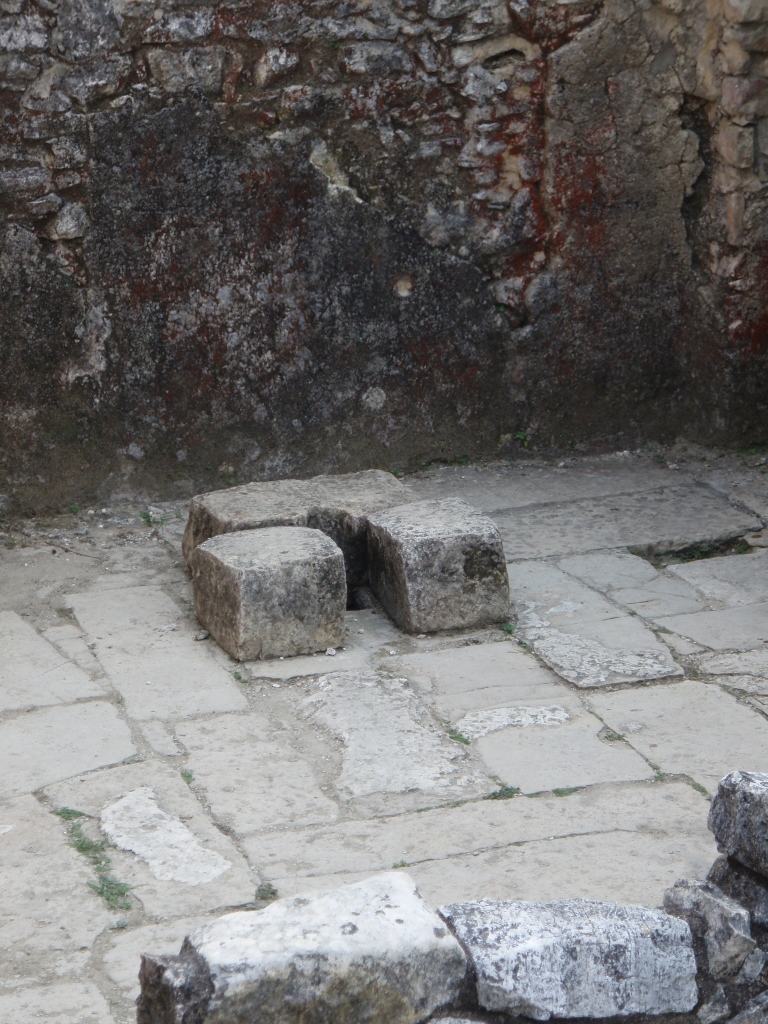 Ancient squat toilet
Ancient squat toilet
This detail and the photo need to be remembered, for I will mention again this squat toilet later in my travel stories.
But, after taking a photo of this detail, I could finally take a photo of myself within the Palace, while the Temple of the Inscriptions constituted my background.
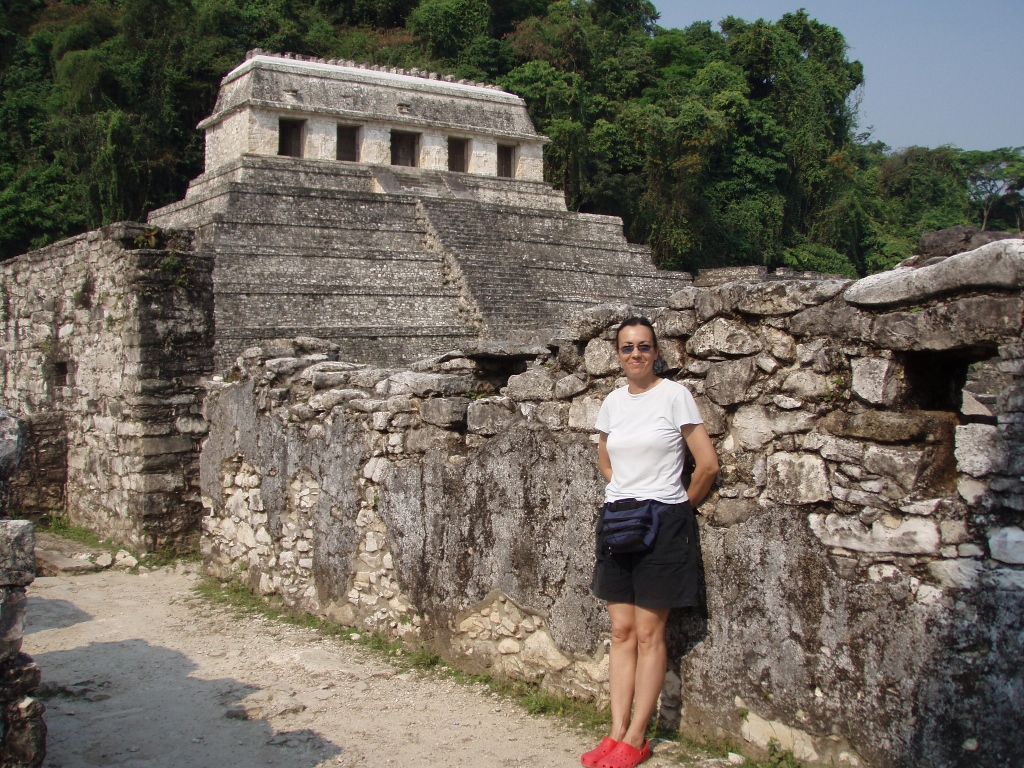 At the Palace
At the Palace
Here I also finished with my sightseeing of the Palace and consequently of the entire archaeological site Palenque in Mexico. Palenque is inscribed on the UNESCO’s World Heritage List and it is one of the most outstanding Classic period sites on the territory inhabited by the ancient Maya people. The entire site covers the surface area of as much as over 1780 hectares and to date the researchers have recorded around 1400 buildings, while only some 10% of them have been studied.
Visitors can go to many more temples and remains of the numerous structures (out of those 10%), but they are either less important or in a more crumbly state or they are still partially confined within the rain forest, so I did not deal with them any longer, satisfying myself with the focus on the most important ones.
Here at the Palace, where I finished with my visit of Palenque, I was closer to the official entrance/exit, but I decided to walk down to the lower exit, since the site is located on a hill. Thus I passed again over the Ballcourt.
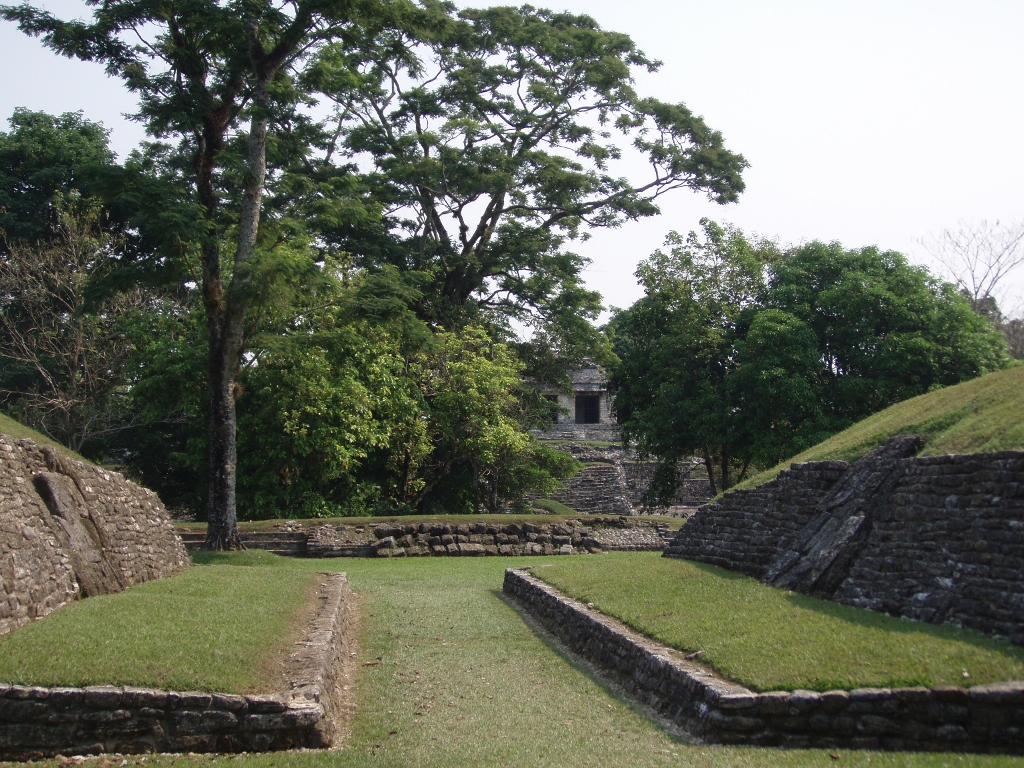 Ballcourt in Palenque
Ballcourt in Palenque
The path that leads towards the lower exit runs beside a few waterfalls and cascades. Although they are certainly interesting, their beauty also depends on the quantity of water that runs down the riverbed during different periods of the year.
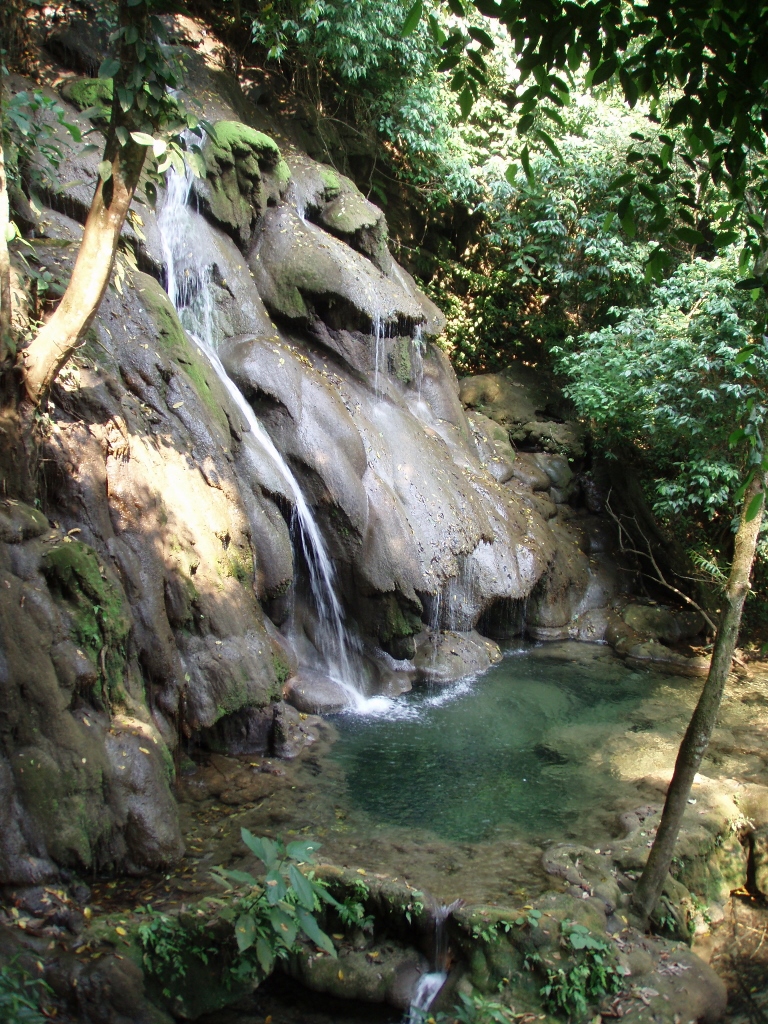 Waterfall on my way to the lower exit from the archaeological site Palenque
Waterfall on my way to the lower exit from the archaeological site Palenque
Close to the exit from the site there is a museum, but I had no more time for any additional visits. I had a coach a little while later, so I wanted to go back to the city in order to eat and drink something before continuing with my journey.
While I was waiting for a local transportation that was to take me back to the city, I took photos of some of the tropical plants.
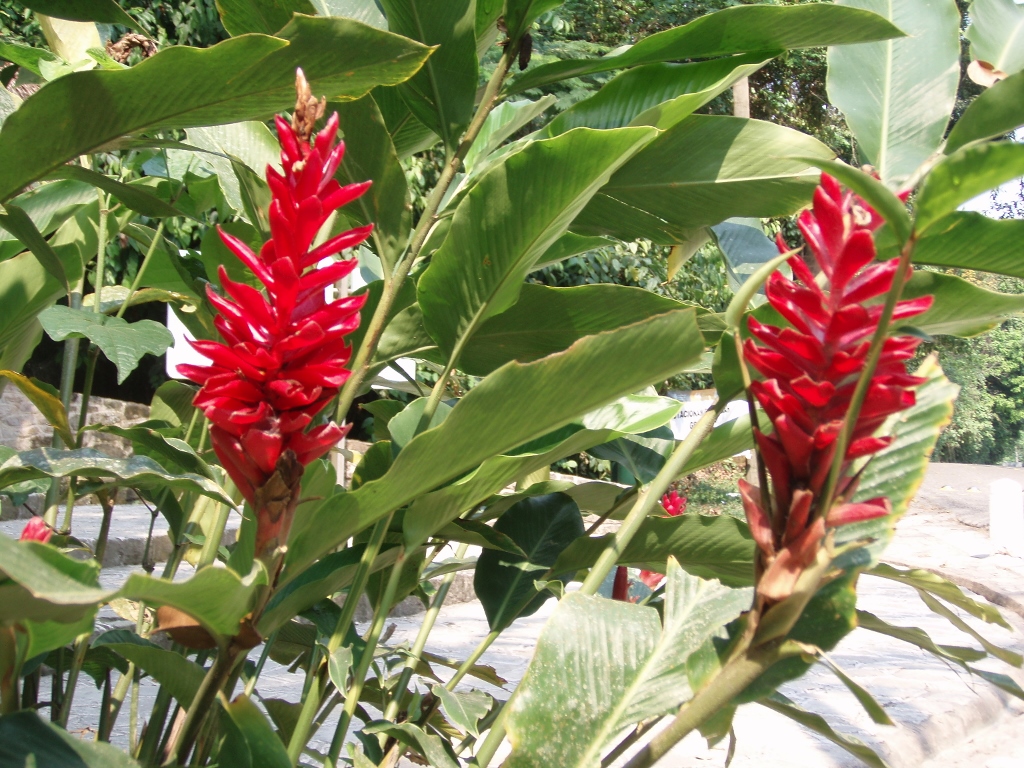 Red ginger (Alpinia purpurata)
Red ginger (Alpinia purpurata)
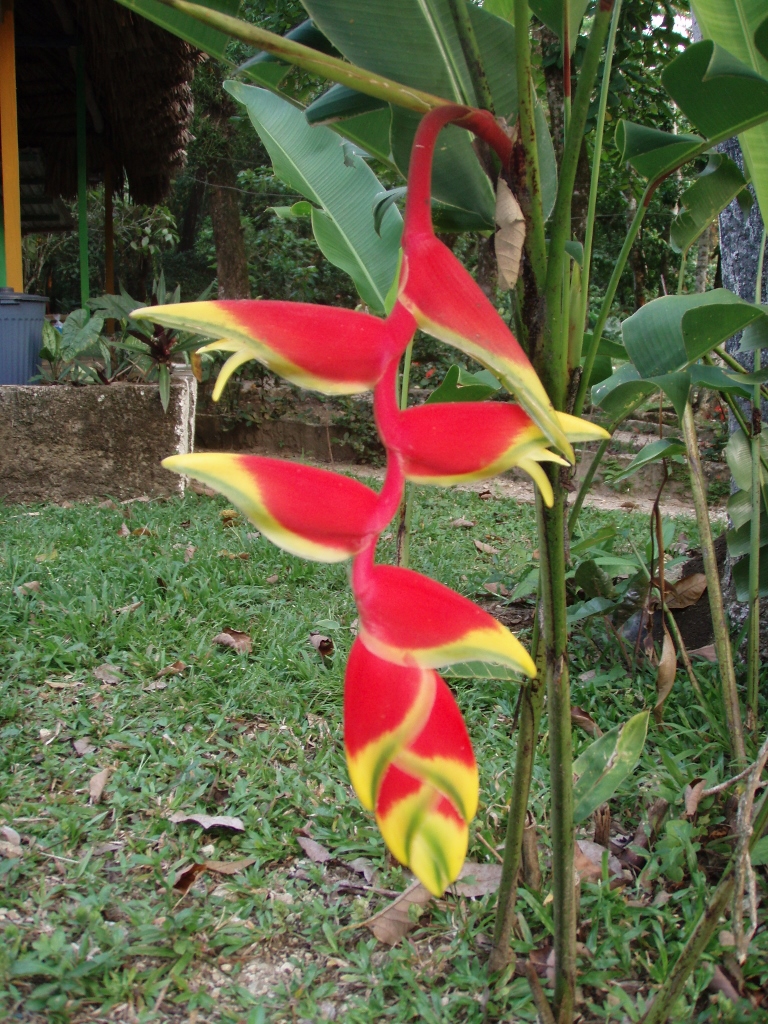 Hanging lobster claw (Heliconia rostrata)
Hanging lobster claw (Heliconia rostrata)
When I got back to the centre, not only did I have breakfast, but I also went briefly to an internet-café, and then I had shower, got my things and went down to the coach terminal. Since I already had a ticket there was no stress and I could be relaxed while waiting to leave for San Cristóbal de las Casas.
While I was at the coach terminal I noticed an elderly couple from the USA who travelled just like me. Admittedly, they had a huge rolling suitcase, plus two big travel bags, but the point is that they were waiting for a coach, i.e., local transportation just like me, and that they were travelling on their own and not with a group, regardless of their age. Looking at them I liked to imagine that I would also do it like this when I was older. But, with significantly less luggage.
The trip to San Cristóbal de las Casas took around five hours and like in the case of most of the places in Mexico where I stayed, here too, I had no idea where I would spend the night. Luckily, literally right next to the coach terminal I saw quite a decent hotel, asked for their price, the price was good and so I took a room. It was still afternoon, so I just left my things in the room and ran out in order to be able to see something of the city.
I have already mentioned that I came here in order to cut the travel to Guatemala in two and in order not to be stuck in the city of Palenque the entire day after the visit to the site. As for the continuation of my travel, right after arriving here I bought a ticket for a coach that was driving to the border with Guatemala the next morning and so the position of the hotel suited me in this respect as well and thus I could go for this leisurely walk around the centre of the city.
What was particularly interesting for me here was that I knew absolutely NOTHING about San Cristóbal de las Casas. As I did not originally plan to be here, I didn’t have even those photocopied pages from a guidebook to Mexico and I also didn’t have a map, which was all very atypical of me.
I asked in which direction the centre of the city was and as it turned out it was some 10-15 minutes away on foot, but I could not find right away what I wanted, so I wandered a little, but it was all fine.
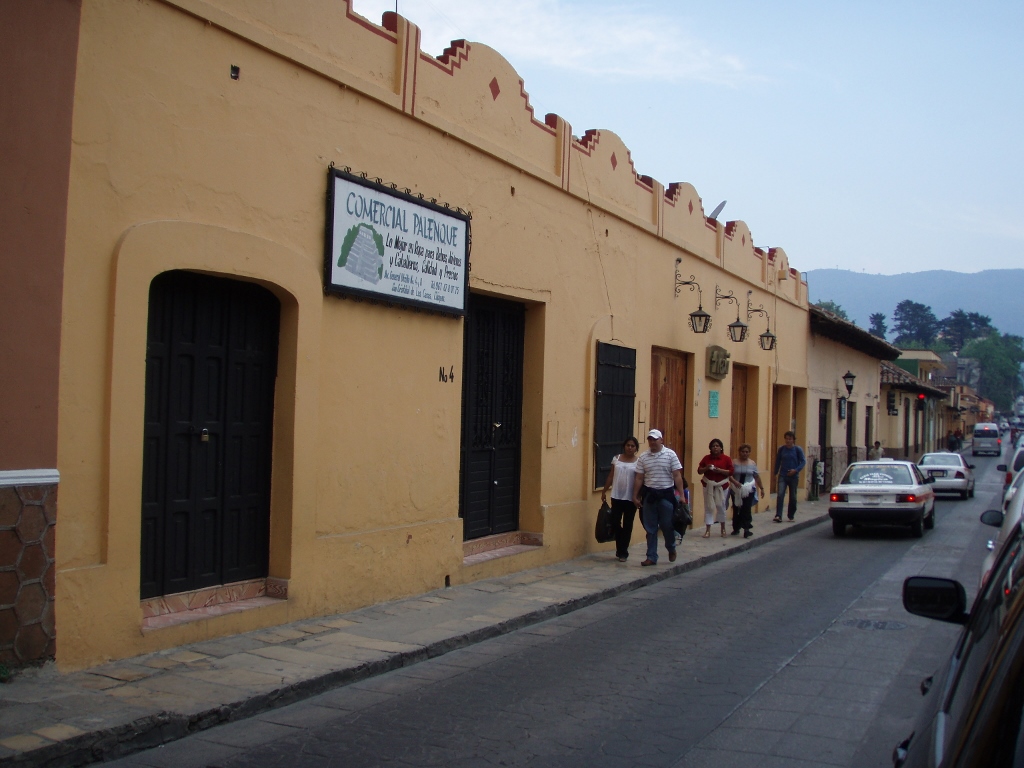 Wandering the streets of San Cristóbal de las Casas
Wandering the streets of San Cristóbal de las Casas
Thus I came across an artisanal market with numerous stands and there was also the Church of Our Lady of Charity (Iglesia de Nuestra Señora de Caridad). The construction of this church started in 1712 and it was a part of the first hospital for the indigenous population.
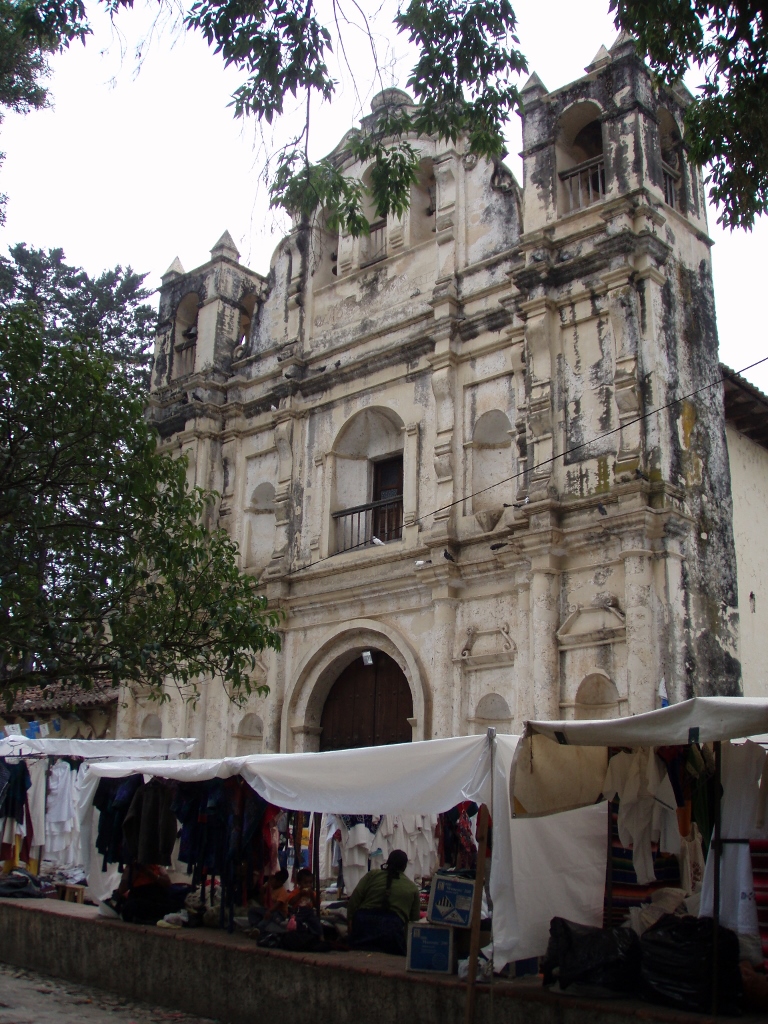 Church of Our Lady of Charity
Church of Our Lady of Charity
Following the colourful stands, in the continuation I came across yet another church that seemed very impressive, so I first thought it must be the Cathedral and then wondered that the old town-planners give up the traditional concept here with a square-shaped clearing in front of the Cathedral from which the city would expand. As it turned out it was in fact the Church of Saint Dominic (Iglesia de Santo Domingo).
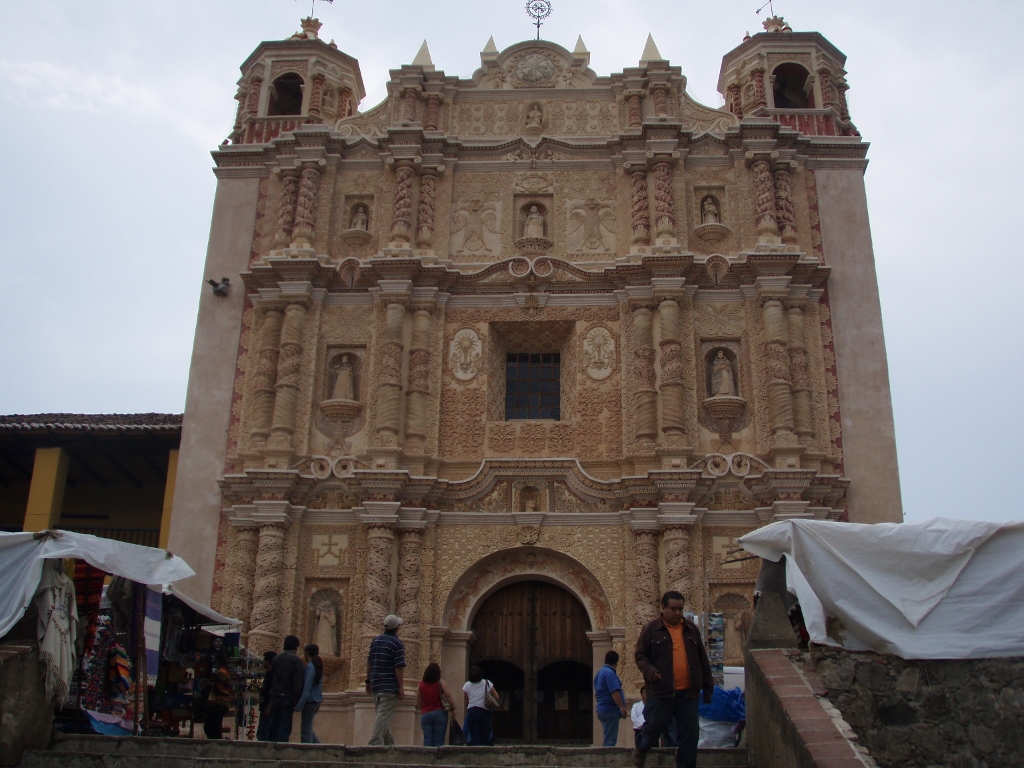 Church of Saint Dominic
Church of Saint Dominic
The Church of Saint Dominic that used to be a part of a convent was built in the 17th century and it represents a typical example of the Chiapas Baroque. With its exceptionally opulent decorations on the front facade it constitutes one of the most decorated churches in all of Latin America.
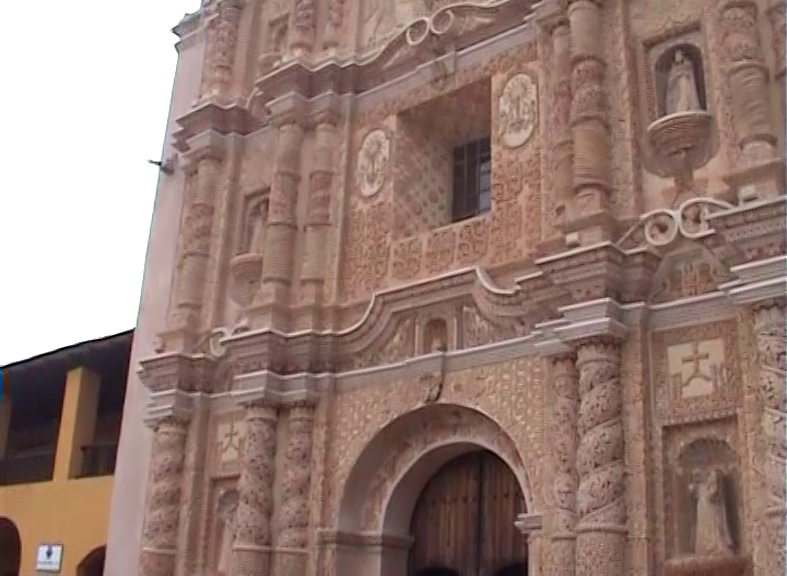 Church of Saint Dominic, a part of the facade
Church of Saint Dominic, a part of the facade
As I’ve said, the local artisanal market, which is in fact quite famous, expanded all the way to this church and there were very diverse, but certainly quite colourful goods on sale here. Still, I resisted the temptation called the souvenir-shopping. In fact, my original plan was to buy a small item in each one of the six countries I was to visit during this journey as a small token that would remind me of these countries. But, since I knew I would return to Mexico, I did not want to buy anything here in order not to carry this needlessly for the next three weeks. However, as it would turn out, along the way I realised that most of the souvenirs in these countries are almost identical, with rare exceptions, and eventually I bought only a couple of small items, while also realising over time that even that was too much. First of all, for a long time now I don’t want to pile up things of any kind and, second, my memories, photographs and stories – well these are the souvenirs (“reminders” derived from the French word for “remember”) par excellance.
What I found most interesting here were people, but I did not want to take too many photos of them, since I knew from experience that people in Latin America are quite sensitive to it. Most of them don’t like when foreign visitors take photos of them (which, I must admit, I fully understand). This is partially founded in some traditional belief that being photographed takes away their soul. Admittedly, some of them will concede against some consideration, so the whole story about the lost soul stands on quite a wobbly basis, but in any case I tried to respect this. Albeit, not too much...
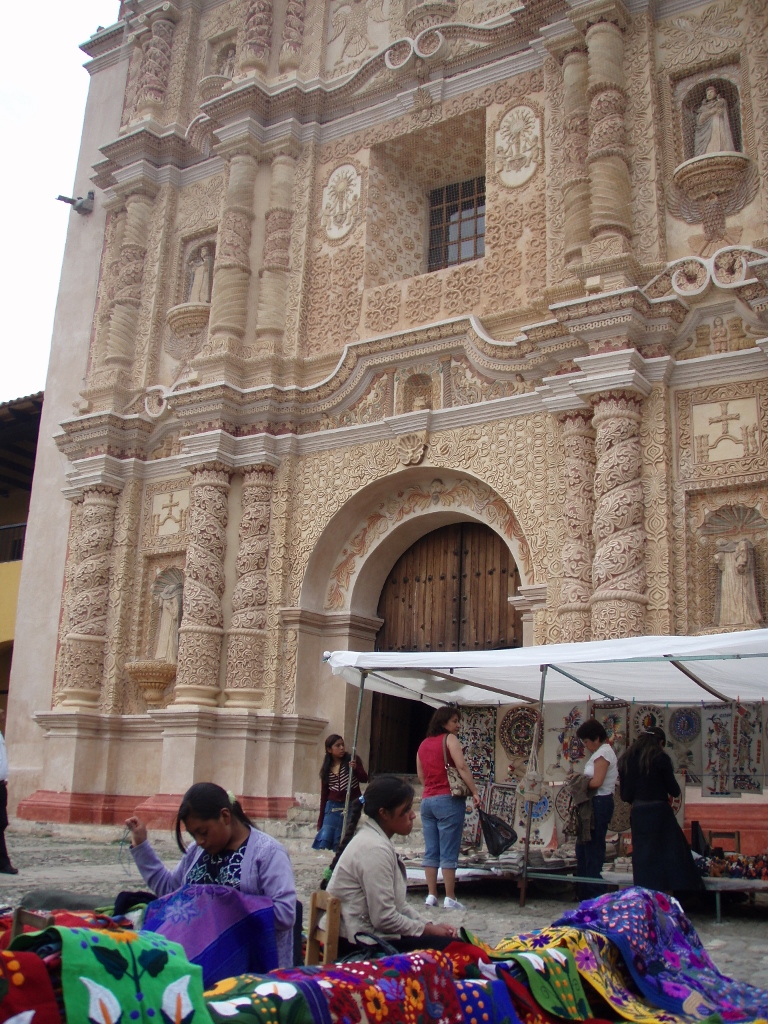 Colourfulness in front of the Church of Saint Dominic
Colourfulness in front of the Church of Saint Dominic
After a short stay around the Church of Saint Dominic, I returned to the corner where the Church of Our Lady of Charity was located and from there the street I was walking along continued into a pedestrian zone.